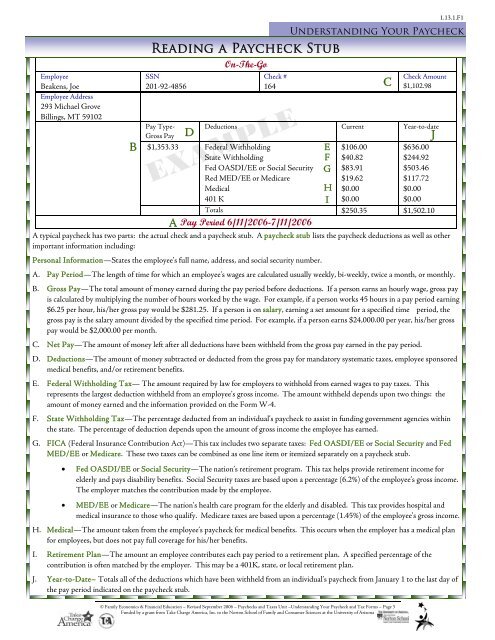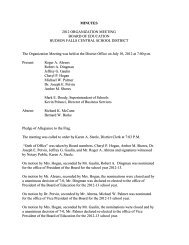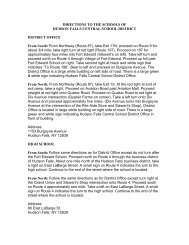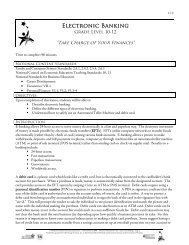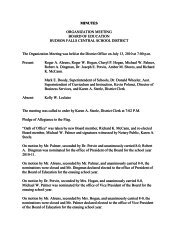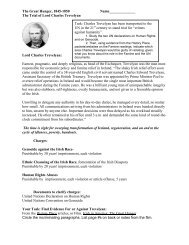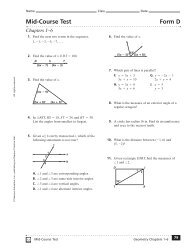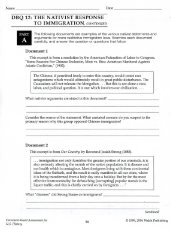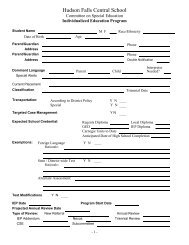Understanding Your Paycheck Information Sheet
Understanding Your Paycheck Information Sheet
Understanding Your Paycheck Information Sheet
Create successful ePaper yourself
Turn your PDF publications into a flip-book with our unique Google optimized e-Paper software.
EmployeeBeakens, JoeEmployee Address293 Michael GroveBillings, MT 59102BReading a <strong>Paycheck</strong> StubSSN201-92-4856EXAMPLEAOn-The-GoCheck #1641.13.1.F1<strong>Understanding</strong> <strong>Your</strong> <strong>Paycheck</strong>CCheck Amount$1,102.98Pay Type- Deductions Current Year-to-dateGross Pay DJ$1,353.33 Federal WithholdingEState WithholdingFFed OASDI/EE or Social Security GRed MED/EE or MedicareMedical401 K$106.00$40.82$83.91$19.62$0.00$0.00$636.00$244.92$503.46$117.72$0.00$0.00ITotals $250.35 $1,502.10Pay Period 6/11/2006-7/11/2006A typical paycheck has two parts: the actual check and a paycheck stub. A paycheck stub lists the paycheck deductions as well as otherimportant information including:Personal <strong>Information</strong>—States the employee’s full name, address, and social security number.A. Pay Period—The length of time for which an employee’s wages are calculated usually weekly, bi-weekly, twice a month, or monthly.B. Gross Pay—The total amount of money earned during the pay period before deductions. If a person earns an hourly wage, gross payis calculated by multiplying the number of hours worked by the wage. For example, if a person works 45 hours in a pay period earning$6.25 per hour, his/her gross pay would be $281.25. If a person is on salary, earning a set amount for a specified time period, thegross pay is the salary amount divided by the specified time period. For example, if a person earns $24,000.00 per year, his/her grosspay would be $2,000.00 per month.C. Net Pay—The amount of money left after all deductions have been withheld from the gross pay earned in the pay period.D. Deductions—The amount of money subtracted or deducted from the gross pay for mandatory systematic taxes, employee sponsoredmedical benefits, and/or retirement benefits.E. Federal Withholding Tax— The amount required by law for employers to withhold from earned wages to pay taxes. Thisrepresents the largest deduction withheld from an employee’s gross income. The amount withheld depends upon two things: theamount of money earned and the information provided on the Form W-4.F. State Withholding Tax—The percentage deducted from an individual’s paycheck to assist in funding government agencies withinthe state. The percentage of deduction depends upon the amount of gross income the employee has earned.G. FICA (Federal Insurance Contribution Act)—This tax includes two separate taxes: Fed OASDI/EE or Social Security and FedMED/EE or Medicare. These two taxes can be combined as one line item or itemized separately on a paycheck stub.• Fed OASDI/EE or Social Security—The nation’s retirement program. This tax helps provide retirement income forelderly and pays disability benefits. Social Security taxes are based upon a percentage (6.2%) of the employee’s gross income.The employer matches the contribution made by the employee.• MED/EE or Medicare—The nation’s health care program for the elderly and disabled. This tax provides hospital andmedical insurance to those who qualify. Medicare taxes are based upon a percentage (1.45%) of the employee’s gross income.H. Medical—The amount taken from the employee’s paycheck for medical benefits. This occurs when the employer has a medical planfor employees, but does not pay full coverage for his/her benefits.I. Retirement Plan—The amount an employee contributes each pay period to a retirement plan. A specified percentage of thecontribution is often matched by the employer. This may be a 401K, state, or local retirement plan.J. Year-to-Date– Totals all of the deductions which have been withheld from an individual’s paycheck from January 1 to the last day ofthe pay period indicated on the paycheck stub.H© Family Economics & Financial Education – Revised September 2006 – <strong>Paycheck</strong>s and Taxes Unit –<strong>Understanding</strong> <strong>Your</strong> <strong>Paycheck</strong> and Tax Forms – Page 3Funded by a grant from Take Charge America, Inc. to the Norton School of Family and Consumer Sciences at the University of Arizona


